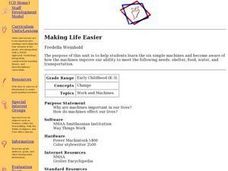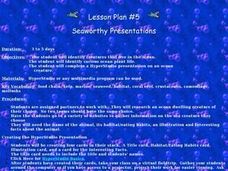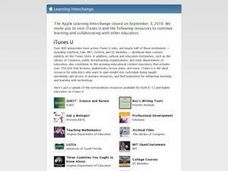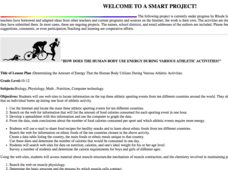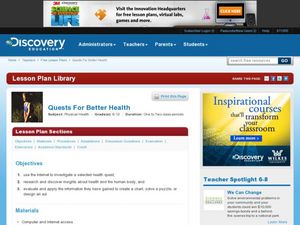Curated OER
A Trip to the Caribbean
Sixth graders use the World Wide Web to research information about the culture of these countries including the religion, types of food, climate, business and industry, and typical clothing of the people in the area.
Curated OER
Cloudy With A Chance of Meatballs
Second graders explore weather. In this weather lesson, 2nd graders read Cloudy With A Chance of Meatballs and participate in four supplemental science activities. Students participate in Internet research, create weather maps,...
Curated OER
Making Life Easier
Students use a chart of the six simple machines and become aware of how the machines improve our ability to meet the following needs: shelter, food, water, and transportation. Students use model cars to experiment with force. They divide...
Curated OER
The Tropical Rain Forest
Young scholars use various web sites to access information about the rain forest. They use the Tropical Rainforest Interactive CD to make their own rain forest pictures and stories and learn facts about the rain forest. They use various...
Curated OER
Virtual Travel Plan
Students navigate the web to prepare for an imaginary trip and record expenses involved. In this state culture and symbol lesson, students gather information to be used in a multimedia project.
Curated OER
Seaworthy Presentations
First graders research ocean animals and plants on the web. For this ocean habitat lesson, 1st graders prepare a multimedia presentation. Students will work on their presentations in pairs and every group should have its own animals or...
Curated OER
Exploring Switzerland
Second graders research the country of Switzerland using the Internet and other resource materials. A variety of excellent materials are provided.
Curated OER
Feeding the Birds
Students build bird feeders. For this aviary lesson, students build different types of bird feeders. This web page includes information on which type of feeder attracts which birds and what food to use with the certain feeder type.
Curated OER
The Alphabet of Culture
High schoolers research a global culture following teacher-created guidelines and break the culture into small sections. They link the sections and find the influences that each component of culture has on another component.
Curated OER
INDUSTRY AND THE ENVIRONMENT
Seventh graders create a final project called Industry X (which was previously researched in the unit) has plans to build in town. There is a special town meeting scheduled to discuss this matter and allow everyone to express their...
Curated OER
Ecosystems
Sixth graders perform various labs, create presentations, and do hands on activities to explore the ecosystem.
Learning Games Lab
Bacteria Sampling
Scholars explore the procedure for bacteria sampling in a virtual lab by first walking through a detailed step-by-step procedure of preparing the samples of raw milk and pasteurized milk, growing the bacteria, and comparing results....
University of South Carolina
Home Sweet Home
Fifth graders will research a biome (land or aquatic) and create a project (diorama, model or another idea of the student's choosing) which includes the geographic features of that biome as well as plants and animals found there and...
Curated OER
"How Sweet It Is: Awareness Today Can Defeat Diabetes Tomorrow"
Young scholars explain the importance of having a healthy body and be inspired to make better choices. They research diabetes to become aware of its symptoms, dangers, and prevention. They identify the relationship between childhood...
Curated OER
INTERPRETING THE EFFECTS OF THE SPANISH AMERICAN WAR ON US CITIZENS.
Students write an article about some aspect of American life during the war. -Examples include: Food, Travel, Weapons, Communication, Maps, Leadership. Each group of three will then be responsible for posting their article to the class...
Curated OER
An Audio Travel Album
Students interview someone who has recently visited a country that students are studying. They use iPod and voice recorder to record the interview and use iPhoto to review and orgainze the interviewee's photos of the trip as well as any...
University of Rhode Island
How Does the Human Body Use Energy during Various Athletic Activities?
Students investigate how much energy is used during different athletic activities. They conduct Internet research to obtain information on the top three athletic sporting events from around the world, and calculate the calories burned...
Curated OER
Quests for Better Health
Students use the Internet to investigate a health quest that is assigned to them. In this investigative lesson students research insights about the human body, evaluate and apply the information to create a chart, puzzle or design an ad.
Curated OER
A World of Favorites
Investigate students' favorites worldwide by having them create and publish a questionnaire to gather information about students' favorites. They will conduct research about a continent, create three web pages and a chart representing...
Curated OER
Investigating Ocean Life
Sixth graders explore the various forms of ocean life. They research a creature that lives in the ocean. Students use their research information to create a series of HyperStudio stacks about their sea creature.
Curated OER
California Missions
Fourth graders explore the Spanish influence upon California missions. Using the internet and other resource tools, they research a particular mission and write about its schedule, events, and beliefs. In groups, 4th graders create board...
Curated OER
It's A Jungle in Here!
Fifth graders research rainforest destruction. In this geography and ecology lesson, 5th graders work as a group to research the effects of logging, farming, and mining on the rainforest. Students gather and display data and information...
Curated OER
Have You Ever Seen a Sea Monkey?
Fourth graders observe brine shrimp over several days. They create drawings showing the growth and development of the shrimp. They research web sites to find out where brine shrimp fit on the food chain and what makes the shrimp unique.
Curated OER
The Insect Files
Students are provided with a physical description of the insect, in words and graphics, including body parts, special adaptations, color, and so on. They explore and report on all four elements of an insect's habitat: food, water,...




